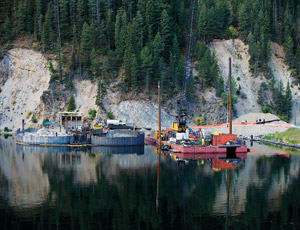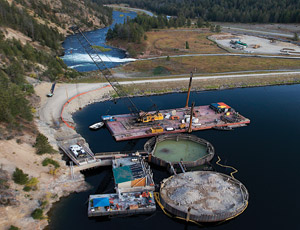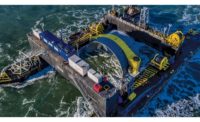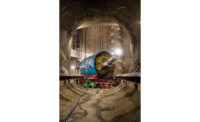For nearly 100 years, Hebgen Dam has held back the water of Montana�s Madison River, forming Hebgen Lake, a 15-mile-long, 2.5-mile-wide popular vacation and fishing spot near Yellowstone National Park.


But in the last couple of years, there have been some problems.
David Hoffman, director of external affairs for Pennsylvania Power and Light Montana, says that something happened to intake bay No. 4 in 2008. The dam has four intake bays, and 17 stoplogs were lost at No. 4 in the middle of the bay.
The Hebgen Dam stoplogs are long rectangular timbers placed on top of each other into pre-made slots inside an intake bay. They are designed to cut off water flow through a dam. The loss of the stoplogs caused the river flow to rise to 2,800 cu ft per second, too high for a fall seasonal flow.
Stoplogs are cut from green fir trees and weigh about 500 lb each. When not exposed to air or sunlight, they will last indefinitely, Hoffman says. During the �60s and �70s, stoplogs were replaced with steel-and-concrete floodgates.
�We are still not exactly sure what happened because diving inspection is pretty difficult down there,� Hoffman says. �We had a 17-ft-tall and 9-ft-wide hole in the dam, causing an uncontrolled flow into the river. We could not reduce the flow effectively, but that wasn�t so bad because we run 3,200 cfs through the system in the spring at high water.�
He says that PPL can actually release up to 3,500 cfs. After the breach, the water ran unchecked for three weeks before crews were able to stop it.
Hoffman says that with creative engineering, workers were able to remove some bent pieces of iron from along the sides of the bay that had prevented installing new logs.
�We used backhoes with special rigging to push logs into place with 80-ton jacks to make the seal,� Hoffman says.
PPL, which owns the dam, built a cofferdam that gave workers access to parts of the dam that are normally submerged.
Before the 2008 breach, PPL Montana submitted a plan to the Federal Energy Regulatory Commission to isolate, rebuild and reinforce the dam�s intake structure.
The project will strengthen and stabilize the dam and make it more resilient in the earthquake-prone Madison Valley. �We took a very broad, comprehensive approach in our design that addresses safety and the seismic activity in the Madison Valley and protects fisheries and public recreation,� Hoffman says.
�Seismic upgrades are the result of inspections that were scheduled down the road, but since we had the damage at the gate, we thought that this would be a good time to do it all.�
The cofferdam consists of two 16-ft-wide, 80-ft-tall steel cylinders filled with 45,000 cu yd of backfill each. The cylinders are separated by a gate that when closed will create a water-tight seal in front of the stoplogs, allowing PPL to make permanent repairs to the damaged dam.
There are two intake structures outside the cofferdam so that when the gate is shut, the water will flow outside the work area. The two cylinders were filled by hauling dirt across the dam, one truckload at a time. Then a 150-ton crane was floated out in front of the dam on a barge. The crane scooped the fill from each truck, then emptied its load into the cylinders.
After PPL engineers calculated the amount of pressure that will be decreased when the water is displaced by the cofferdam on the lake side, they tied the structure to bedrock to make sure they didn�t have problems with lost water pressure on that side of the dam.
�We want to make sure the structure doesn�t want to tip,� Hoffman says.
When the intake side is dewatered, all stoplogs will be removed. Intake bays one, two and three will be filled with concrete. Some design features of the new single-bay intake structure include a secondary emergency shutoff gate�a large gate at the bottom for emergency flow.
No new engineering was performed on the dam itself because there has never been any indication that the integrity of the dam is in question, Hoffman says. �We have monitoring equipment on the dam so we can see if here is any movement or change in its structure,� he says.
An earthquake in 1959 caused Montana Power, the dam owner at the time, to dewater the lake in 1960. At the time, that was the only way to get to the intake structure because of how the dam was built. Today, dewatering is not an option because so many people rely on the dam for recreation and resources.
�The work will not affect the elevation of the lake or river flows, which are critical to aquatic resources and the summer recreation and tourism in the Madison Valley,� Hoffman says. For public-safety reasons, the U.S. Forest Service has closed the area around the dam during construction.
�It is probably going to be 2013 before we are finished, and we are into the project about $10 million to date. I suspect we will add another $10 million or $15 million when we are done,� he says.
div id="articleExtras"




Post a comment to this article
Report Abusive Comment